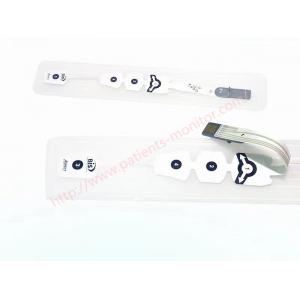
Add to Cart
186-0106 Covidien BIS Sensor For Anesthesia Machine 10.5 X 1.1 Inch Standard Pediatric,PVC Free 4th Electrode Disposable
Consider the complexity of the decisions you will face You should incorporate the additional security of BIS ™ verification into your operations. BIS technology is used in millions of anesthetic procedures. This can provide information on the immediate and patient-specific effects of general anesthesia on the brain.
• Raw EEG data is obtained from a sensor mounted on the patient's forehead.
• The BIS monitoring system processes the EEG data and calculates a number from 0 to 100 which directly measures the patient's level of consciousness.
• A BIS value of 100 indicates that the patient is fully awake.
• A BIS value of 0 indicates brain inactivity.
BIS Index Range and Clinical States
| BIS Index Range | Clinical States |
| 100
| Awake – Responds to normal voice |
| 80 | Light/Moderate Sedation – May respond to loud commands or mild prodding/shaking |
| 60 | General Anesthesia – Low probability of explicit recall – Unresponsive to verbal stimulus |
| 40 | Deep Hypnotic State |
| 20 | Burst Suppression |
| 0 | Flatline EEG |
| Sensor dimensions | 10.5 X 1.1 Inch |
| Weight | Around 3.7g |
| Weight (packaged) | Around 16.8g |
Information about brain reactions
• BIS™ monitoring can help clarify the difference between brain and spinal cord responses, allowing you to manage anesthesia goals for hypnosis, analgesia and immobility.
• Because BIS™ technology measures electrical activity in the brain, it provides a direct correlation to depth of consciousness (hypnosis).
• Response to surgical stimuli is often an indicator of the need for additional analgesia. These responses are normally mediated in the spinal cord.
• BIS monitoring allows consciousness and sedation to be assessed separately from cardiovascular response.
The BIS™ sensor family
The family of BIS sensors includes
• BIS™ 4-electrode sensor for adult patients undergoing general anesthesia or sedation
• BIS™ Extended Sensor for long-term monitoring of adult patients, such as those in the ICU
• BIS™ Pediatric Sensor for Smaller Patients
• BIS™ Bilateral Sensors are able to detect hemisPHiliphhiliperic differences in the brain, which may be useful for advanced monitoring applications
BIS™ quatro 4-electrode sensor
Measure brain activity in adult patients receiving general anesthesia or sedation. Part number 186-0106, box of 25
BIS™ Bilateral Sensor
Lets you detect hemisPHiliphhiliperic differences in the brain, which may be useful for advanced monitoring applications.
Part number 186-0212, box of 10
Note :Not compatible with BIS™ 2-channel systems. BIS™ LOC 4-channel cables required.
BIS™ pediatric sensor
Measures brain activity in pediatric patient
Part number 186-0200, box of 25
Note :Ages four and up recommended
BIS™ extend sensor (extended use)
Measures brain activity in adult patients who require longer periods of monitoring, including those in the ICU
Part number 186-0160, box of 25